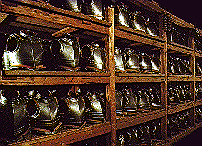 Imperial Austria: Treasures of
Art, Arms and Armor from the State of Styria
Imperial Austria: Treasures of
Art, Arms and Armor from the State of Styria
The Landeszeughaus Graz
-
Two-handed sword, made in southern Germany, c.1600;
Joanneum Graz, Landeszeughaus. Photo: Richard Margolis
The Landeszeughaus, the Styrian State Armoury in Graz, contains more than 32,000 examples of Renaissance and Baroque arms and armor. Since Styria was constantly threatened by invasion, Styrians began to stockpile arms and armor for defense. By the middle of the 16th century the Styrians had hired an armskeeper to maintain and manage the war materials they had been accumulating. These arms were housed in sheds and vaults inside Graz's city walls.
In the 17th century these objects were transferred to the Landeszeughaus,
a Renaissance palace immediately adjacent to the Landhaus (the seat of
government of Styria). They are densely stored in tall wooden racks,
hang from pegs, or are displayed on frames. Most of the contents were
made for the levy who were the equivalent to drafted troops.

The Landeszeughaus ("provincial armory").
Photo: Matthias Wimler
The facade of the armory (on the left) was built in
1642-1644 by architect Antonio Solario. Next to it is the Landhaus,
built eighty years earlier.

Late 16th century cuirasses worn by the Hussars, a type
of conscripted light cavalry. Photo: Luigi Di
Giovine, © Casa Editrice Bonechi
By 1699, Styria with its Landeszeughaus, which housed an incredible 185,000 objects, no longer needed to defend itself. Although Maria Theresa dismantled other Austrian armories, she honoured the Styrians in 1749 by allowing this one to survive. The Landeszeughaus became, and remains today, a symbolic memorial to the history of Styria and its inhabitants, and an extraordinary repository of Austrian Renaissance and Baroque artistry and history.






